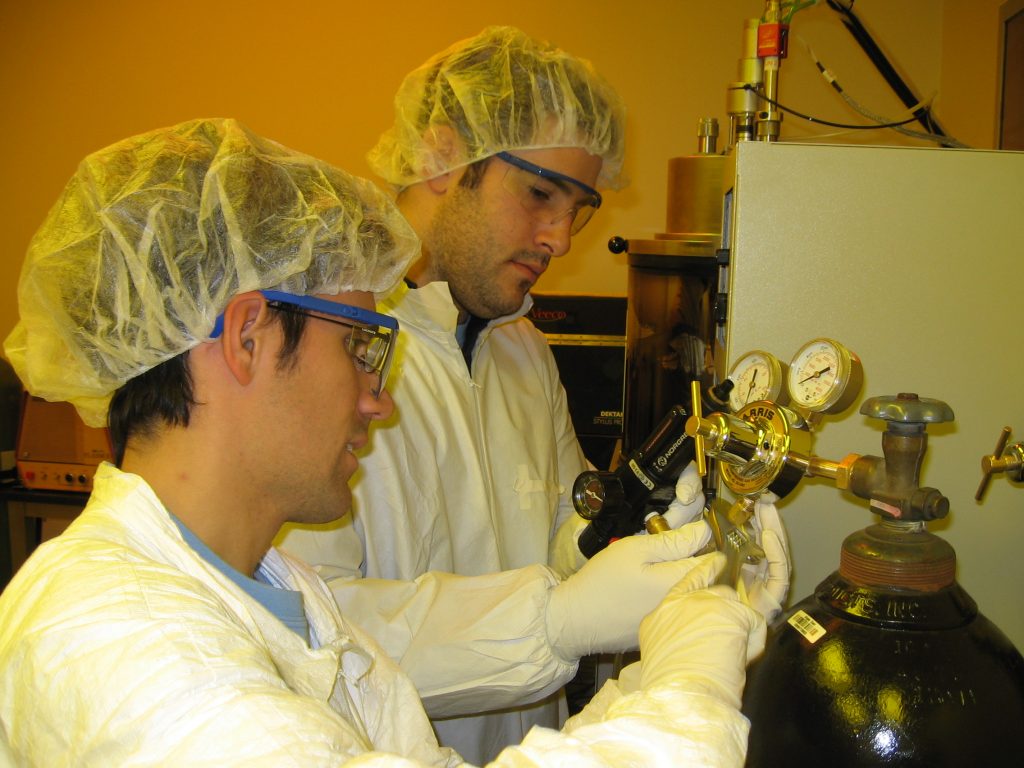
— Undergraduates Aaron Gerratt and Peter Fallon working with compressed gas cylinders and a DC sputter tool in the Tufts Microfab c. 2010.
Mechanics I (ME20)
Last taught Fall 2023. This is a required undergraduate introduction to statics and strength of materials. We first review static force balances and moment balances, work on statically determinate structures like trusses using matrix methods. We build and test some truss structures using Arduino-based data acquisition and load cells for take-home labs. We move on to develop the three-dimensional equations of linear elastic solid mechanics, and look at some important one dimensional solutions including bars in tension and compression, circular shafts in torsion, and symmetric long slender beams in bending. We also learn to use finite element analysis to compute stress and strain distributions and deflections of more complex structures. We define stress and strain, learn about Hooke’s law for linear elastic materials, and look at some simple failure theories. We use Matlab for computational work and Comsol Multiphysics for FEA work. Take home labs include calibration of a load cell, design, construction and testing of trusses, and FEA analysis, design, and testing of a 3D printed or thermo-formed spring.
Acoustics (ME126/ME139)
Last taught Spring 2024. This is a graduate course in the Mechanical Engineering department . We look at physical acoustics from an engineering perspective. We derive the acoustic wave equation and look at some of its classical solutions. In the first part of the course we discuss acoustic intensity, impedance, transmission and reflection of plane waves from boundaries, impedance matching, and partitions. In the second part of the course we consider radiation from various types of sources, including a discussion of beam patterns and far field approximations. In the final part of the course we discuss acoustic filters, architectural acoustics, and transducer models. Brief descriptions of some of the major features of human hearing are also be included. The course includes computational (finite element and numerical computing in Matlab) components and hands-on measurement of sound including spectral analysis.
Dynamics and Vibrations (ME21/ME37)
Last taught Fall 2016. This is a required undergraduate course for Mechanical Engineering students, usually taken first term Junior year. Kinematics and kinetics of particles and of rigid bodies in plane motion (2D), and rigid bodies in 3D. Free and forced vibration of damped and undamped single-degree of freedom systems. Matlab is used for modeling and data analysis including nonlinear ODE numerical solutions. Usually we spend some time on Fourier series and spectral analysis related to vibrations. Sometimes we have time to do coupled electro-mechanical and fluidic-mechanical systems modeling. In class mini-projects include design and experimental activities.
System Dynamics and Control (ME31/ME80)
Last taught Spring 2023. In this course, we study system behavior and properties in the time and frequency domain, and the design of linear control systems for single input single output systems. Laplace transform techniques. Use of MATLAB and SIMULINK simulation in solution process. Feedback control design techniques including frequency response methods, root locus, and PID controllers. Hands on embedded control design and development using microcontrollers. Some mechatronics, electronics, and programming.
Microelectromechanical Systems, MEMS (ME103)
Last taught Fall 2024. In this course, we study the design and fabrication of microelectromechanical systems (MEMS). These are devices with length scales in the range of 1 micron to 1 millimeter. The course includes six laboratories where students will work in the cleanroom fabricating devices using microfabrication techniques. A significant design component is included, including three group design problems, all of which will be fabricated by the students in the laboratory. We learn about fabrication processes and tools, materials, device physics, modeling, design, and measurement of microsensors, microactuators, and microfluidic systems.
Instruments & Experiments (ME70/ME18)
Last taught Spring 2025. This course is the hands-on “junior lab” for mechanical engineers. It is a required course where students gain experience with mechanical experimentation, instruments, data acquisition, data analysis, electronics and software for measurement, and report writing. The course has a major laboratory component in which students take mechanical measurements such as temperature, pressure, strain, vibration, force, acceleration, and fluid flow. We work on frequency response and filters, statistics for experimental design and analysis, and data processing and analysis. National Instruments LabVIEW is taught as a language for data acquisition and processing.
Advanced Vibrations (ME122/ME137)
Last taught Spring 2017. This is a graduate course in the Mechanical Engineering department. We work on describing, measuring, predicting, and mitigating (or generating) mechanical vibrations. We start with analytical solutions to lumped mass-spring systems, look at frequency response and modal analysis of lumped element systems, and then move on to continous vibration in strings and waveguides, vibration in membranes and plates, and wave travel in 3D elastic solids. The course includes computational (finite element and numerical computing in Matlab) components and hands-on measurement of vibration including spectral analysis.
Software Tutorials
Tanner EDA L-edit
This is a Tanner EDA L-edit tutorial that I put together for my ME103 students in Spring 2007. L-edit is a layout editor for MEMS devices.
Jurgen Thies’s The LayoutEditor
This is a tutorial for Jurgen Thies’s The LayoutEditor, an inexpensive but excellent mask layout tool. The tutorial was created for my ME103 (MEMS) students in Fall 2009.
Comsol Multiphysics for Acoustics
Here is a tutorial for Comsol Multiphysics aimed at solving acoustics problems. This was introduced in ME139, Spring 2008 (Comsol 3.4), and updated in Fall 2012 (Comsol 4.3).
Labview Toolkit for the Lego NXT
This is a tutorial for embedded programming of the Lego NXT brick using the Labview NXT Toolkit that I put together for my ME80 students in Fall 2008. This is a nice environment for teaching controls: the lego brick works very well with sample times in the 1-10 ms range, you have plug-and-play sensors and actuators, and mechanical flexibility for open-ended hands-on homeworks. NI Labview is a very popular environment for automation programming, and allows the students to implement their controllers on the brick. The slides from ME80 Fall 2008 are here
